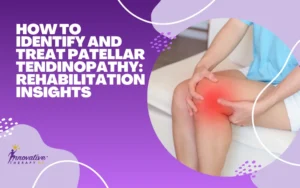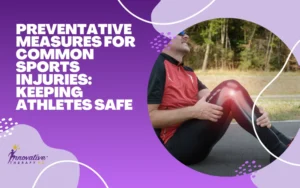Living with hip pain is like living in a mud-filled swamp up to your armpits.
Your every movement is hard work and forward progress is small.
After more than 30 years as a Physical Therapist, I have worked with thousands of people to address hip pain.
Let me boil hip pain down to the facts:
Hips are the key to so much of our movement.
When our hips hurt, our life can come to a screeching halt.
We can’t move easily or freely when the hips hurt.
Hip pain has a different definition and location for different people.
Defining the cause(s) of your hip pain is essential, but first, let’s discuss what are the first signs of hip problems.
Jump To Section:
- What Are The First Signs Of Hip Problems?
- What Are The Common Causes of Hip Pain?
- How Do You Know If Something Is Wrong With Your Hip?
- How Long Should I Wait To Get Treatment For Hip Pain?
- How Do You Know If You Need Physical Therapy Or Surgery?
- How Can I Stop My Hips From Hurting?
- What’s Your Next Step?
What Are The First Signs Of Hip Problems?
The first signs of hip problems are pain in your hip, hip socket, hip flexors, ball and socket joint, or other joints in that area.
If you start to feel pain in your hips or have a medical history of hip pain, it is always a good idea to get a physical exam for a proper diagnosis.
However, there are some common more specific signs that you should be looking out for.
Here are some common signs that you have a hip problem:
Stiffness In Your Hip Joint
When you change positions such as standing up from a sitting position or getting out of bed you may notice stiffness in the hip joint, groin, or pelvic region.
Falling into a chair also called “plopping” is an indication you may have a hip problem.
Stiffness, discomfort, or pain that lasts more than 20 minutes after you get up indicates it is time to take action to address your hip issues.

Pain In The Back Of Your Pelvis When You Sit Or Have Been Sitting For Several Minutes
This is an indication that the sacral iliac (SI) joint is out of balance or inflamed.
This can cause both hip and knee pain.
The pain radiates to the front of the pelvis and then down to your knee.
A skilled therapist can bring these joints into balance however the muscles also need to be brought into balance to keep the sacral iliac joint from causing you hip strain in the future.
Discomfort Or Pain On The Outside Of Your Upper Thigh (the saddlebag area)
Pain on the outside of your upper thigh where your “saddlebags” are is an indication of trochanteric bursitis.
It frequently starts with mild pain when pressure is applied to the area. It can get severe fast.
Pain or discomfort in this outer upper thigh “saddlebag” area when you sleep on your side is a good indication you are having trochanteric bursitis.
Stop sleeping on that side.
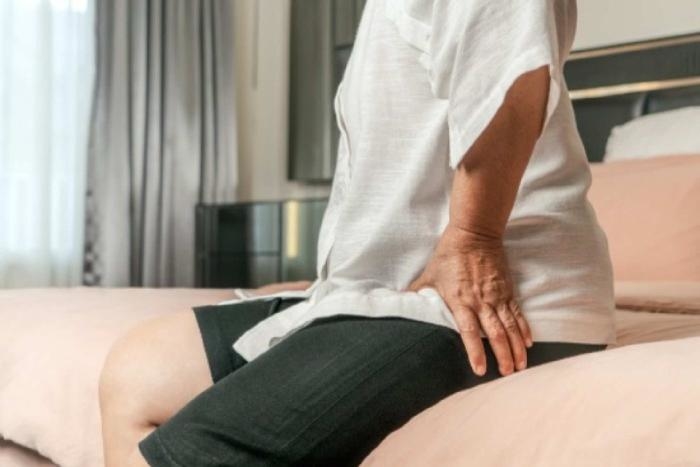
Discomfort or Pain In Your Seat When You Sit On It
Pain in your seat when you sit is usually bursitis but can be tendonitis.
Either of these issues can be a pain in the buttocks.
It is a result of swelling in the area of the pain, at least in the beginning.
It starts mild but can grow fast.
Discomfort or Pain After You Have Been Walking
Pain that increases with activity such as walking or standing reveals that the muscles in and around the pelvis and hip joints are not working in a good balance.
Muscles around the hip need to work as a team.
When the muscles are not working as a team, walking and other repeated movements will increase discomfort and eventually cause hip pain.
The hip muscles might be weak or have poor endurance.
Weakness is the opposite of strength – basically how much force can be created against resistance.
Endurance is a function of how long the muscles are prepared to continue an activity without giving out to fatigue.
If you are not used to walking start with short distances and build up gradually.
Check your shoes.
Worn shoes can cause imbalances in your walking pattern and this fatigues muscles causing discomfort and pain.
Getting the hip muscles to work together is a powerful way to relieve hip pain.
This usually requires a skilled professional.
Just doing some “hip exercises” can actually make this issue worse by strengthening the already strong muscles and tightening muscles that are already too tight.
Pain That Lingers After Surgery Done For Hip Fractures or Total Hip Replacement.

Too often people have lingering pain following surgery for hip fractures or hip joint replacements.
This is frequently due to muscles working out of balance.
This means some muscle or tendon strain due to overuse is happening while other muscles or tendons are not working enough.
People who have had surgery for hip fractures or a hip replacement often accept lingering hip pain believing that it is as good as it gets.
This is usually not true and learning how to bring the muscles back into working as an integrated team is likely not as difficult as you think.
The pain can be resolved.
Listen to your body!
When your body communicates these common messages about your hip pain, take action to keep the issue from getting worse.
What Are The Common Causes Of Hip Pain?
Let’s take a look at some of the most common causes of hip pain.
For some reason, the location of your “hip” is dependent on the culture in which you grew up.
No worries – The most common cause of “hip pain” can still be revealed with a few graphics and short explanations.
Sacral Iliac (SI) Joint Pain Is Frequently Called Hip Pain
The SI joint is in the back of your pelvis.
The pain wraps around your body into your groin area causing significant groin pain.
It can extend down your thigh to the knee most commonly.
There are times the pain goes clear to the foot.
It is important to determine if the pain is from the hip ball and socket joint or the sacral iliac joint as the treatments are very different.
For further reading on Sacral Iliac (SI) Joint and how it can cause pain, read my recent article.
Bursitis
Bursas are fluid-filled sacs in strategic locations which cushion one structure (tendon) while it glides over the top of another structure (bone).
There are several bursas in the hip area.
Hip bursitis is the inflammation or swelling of one or more of these fluid-filled sacs.
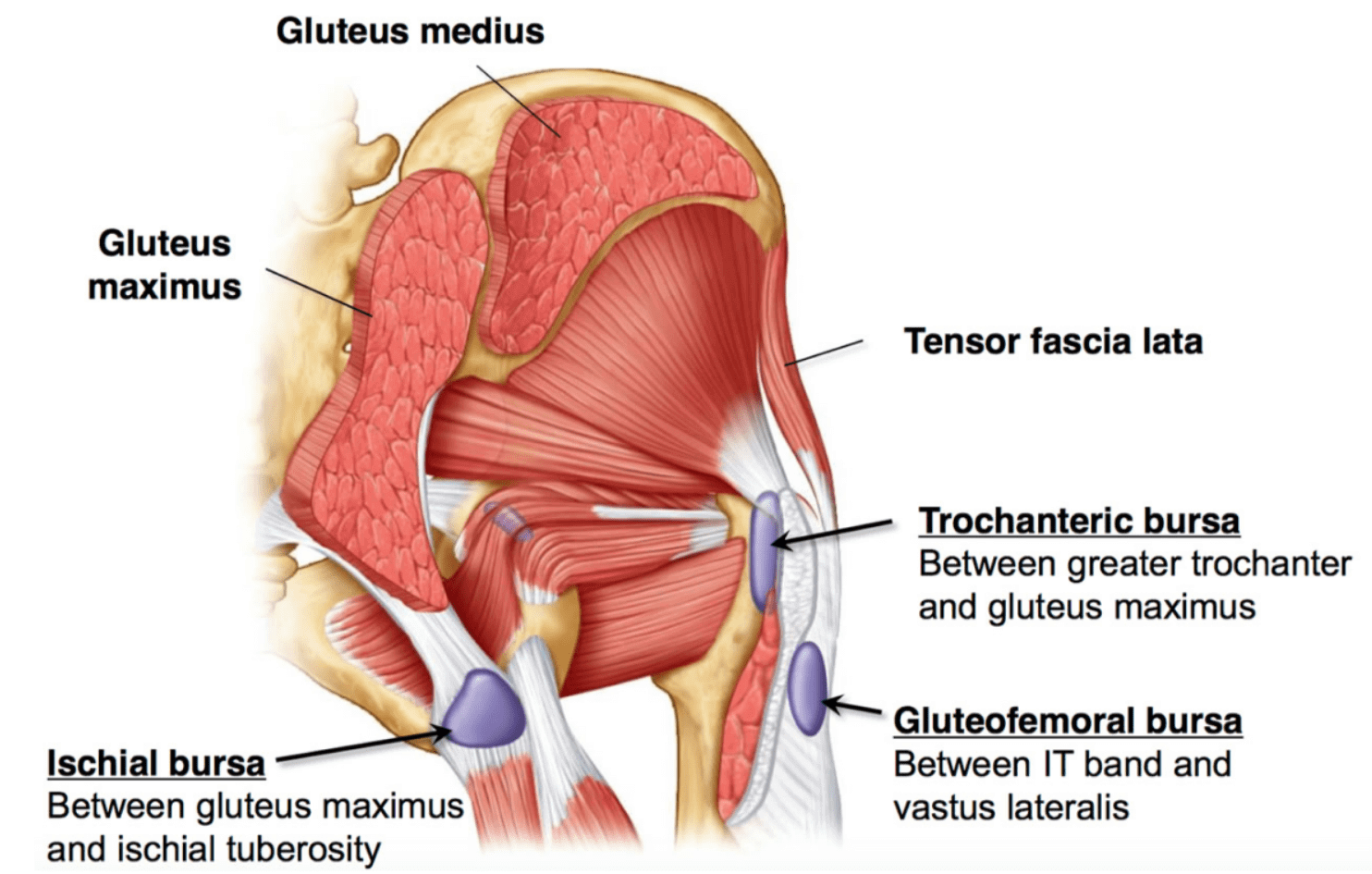
Arthritis
Arthritis literally means inflammation or swelling in the joint.
Hip arthritis is usually felt in the groin area.
Hip arthritis can be caused by the wearing of the joint, especially if the joint surfaces are worn unevenly.
Uneven joint wearing is caused by uneven muscle use, habitual patterns of movement which are uneven, and strong dominance of one side of the body over the other side are among many other issues.
It can happen from a combination of issues.
There are many types of arthritis that can affect the hip joint some of them include:
- rheumatoid arthritis
- hip osteoarthritis
- inflammatory arthritis
- joint infection
Muscle Imbalances
Muscles have partners – the agonist and the antagonist.
The roles change rapidly and frequently throughout the day, even during specific activities.
The patterns of connection are fascinating but when there is hip flexor strain without the balance of hip extensor muscle balance stress injuries can result.
The flexibility of the muscles around the hip joint also plays a role in how the joints of the hip and pelvis balance.
This can cause hip strain up the back and down into the knee.
Hip Fractures
This seems like it might be obvious, “Help I have fallen and I can’t get up!”
This is the most obvious type of hip fracture.
There can be small micro-fractures in the hip bone which are the result of osteoporosis.
These types of fractures can be happening without you knowing it causing hip pain and loss of function.
How Do You Know If Something Is Wrong With Your Hip?
Hip joint pain is felt in the groin area and if you are having pain in your groin, you very likely have something wrong with your hip.
- If you have pain in the buttocks, it is likely you have sacral iliac joint pain.
- If your hip pain is deep in the meat of your buttocks you may likely have piriformis syndrome.
- If you have pain in the “saddlebag” area at the top of the thigh you likely have bursitis.
Please seek help for any of these issues as they can go from mild to severe fast.
Treatment for each of these issues is different. You may want to get a complete hip evaluation by a skilled health care provider.
How Long Should I Wait To Get Treatment For Hip Pain?
When you are suffering from any type of hip pain you should never wait to seek help because conditions can get more severe quickly when untreated.
That being said, it also depends on several factors such as:
- How long do you want to take to get the hip pain well?
- How much severe pain do you deal with before you can’t cope any longer?
- Are you someone who values your health or takes it for granted?
The more severe the pain is when you seek assistance the longer the process of getting well usually takes. There is more to get healed.
Hip pain can be mild for a long time and then flare up hard and fast.
My grandpa used to say a stitch in time saves 9.
I am not sure if that is 9 stitches or 9 trips to the doctor or $9,000. Seeking help sooner is usually means less time in treatment.
Treating a problem before it is a screaming mess is usually easier for you in more ways than one.
I had a man come in a few years back and he had waited a long time.
I said, “We can get you in a much better place but we are both going to need to commit to the process which will be lengthy.”
He chooses not to commit.
My heart was sad because no one can fix you, except you.
Others can only help, coach, and set up the tissues for healing around a prosthesis or repair.
An orthopedic surgeon can put the parts in a good relationship with each other so healing can happen faster but you still have to get them strong, build endurance and bring the flexibility back.
A physical therapist can teach you how to perform the best sequence of activities to strengthen and stretch your muscles but you have to do it.
The bottom line is – don’t wait. Get help.
How Do You Know If You Need Physical Therapy Or Surgery?
When deciding between physical therapy or surgery for your hip pain it is always best to start with the most conservative option first, physical therapy.
When you have mild to moderate hip pain start with physical therapy.
If you have severe pain, a hip fracture or you have lost a huge amount of functional abilities due to the pain in your hip, surgery may be the only way to resolve the issues.
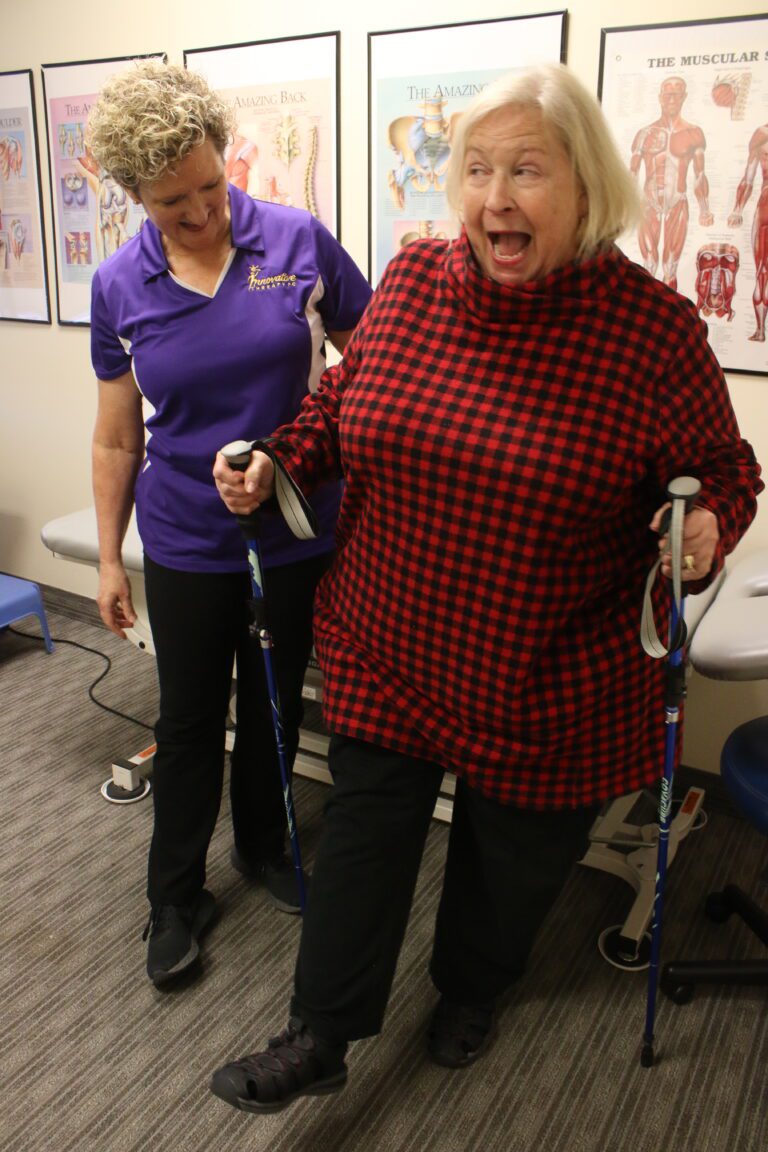
Surgery is the most invasive medical treatment and comes with many risks.
- Movement without touch is the least invasive treatment.
- If an issue can be solved without breaking the skin there are fewer risks.
- If an issue can be solved without touching the skin there are even fewer risks.
- If chemicals (medications) are used orally the risk increases but when the chemicals (medications) are used via injections there is a further risk.
- If an issue can be solved with natural food source products supporting the healing the risk decreases.
This being said, a relative of mine recently experienced a hip injury that resulted in a hip fracture.
I am hugely grateful to the orthopedic surgeon who performed the hip bone repair to help her get to the point she could begin rehab with a terrific therapist.
How Can I Stop My Hips From Hurting?
The best way to stop your hips from hurting would be to do what is called “rescue activities” which can make you more comfortable but usually have a short life span of relief.
Here are a few examples of hip pain rescue activities that you can do at home:
- Apply ice or heat to the painful area.
- Stretch the tight muscles in the hip region, piriformis muscle, or the hip flexor muscles as demonstrated in the video links
- Use your favorite pain relieving rub. My favorite is doTerra deep blue
- Use a hot tub or hot bath, just be sure the pain isn’t going to keep you from getting out of the tub.
- If these don’t help call us at 214-225-8530
What Is Your Next Step?
Now that you are more familiar with the common causes of hip pain, how to self-diagnose common conditions, and basic ways to reduce the pain you may want to dig a bit deeper.
I invite you to watch a video I made for you about the BODi Power System, which I developed to help you learn how to help your hips heal.
I also have a FREE resource that will show you 5 Daily Stretches That Can Reduce Your Hip Pain In 1 Week Or Less.
Just provide your name and email in the form below and it will be instantly sent to your inbox.
If you think I missed something or have a more specific question for me, please email me directly at mary@innovativetherapypc.com and I will get back to you promptly. (I read every email)



